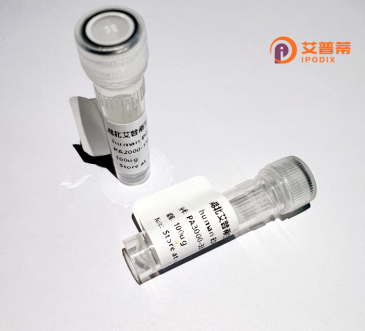
| 纯度 | >90%SDS-PAGE. |
| 种属 | Human |
| 靶点 | UBFD1 |
| Uniprot No | O14562 |
| 内毒素 | < 0.01EU/μg |
| 表达宿主 | E.coli |
| 表达区间 | 1-309 aa |
| 活性数据 | MAAAGAPDGM EEPGMDTEAE TVATEAPARP VNCLEAEAAA GAAAEDSGAA RGSLQPAPAQ PPGDPAAQAS VSNGEDAGGG AGRELVDLKI IWNKTKHDVK FPLDSTGSEL KQKIHSITGL PPAMQKVMYK GLVPEDKTLR EIKVTSGAKI MVVGSTINDV LAVNTPKDAA QQDAKAEENK KEPLCRQKQH RKVLDKGKPE DVMPSVKGAQ ERLPTVPLSG MYNKSGGKVR LTFKLEQDQL WIGTKERTEK LPMGSIKNVV SEPIEGHEDY HMMAFQLGPT EASYYWVYWV PTQYVDAIKD TVLGKWQYF |
| 分子量 | 33.3 kDa |
| 蛋白标签 | His tag N-Terminus |
| 缓冲液 | PBS, pH7.4, containing 0.01% SKL, 1mM DTT, 5% Trehalose and Proclin300. |
| 稳定性 & 储存条件 | Lyophilized protein should be stored at ≤ -20°C, stable for one year after receipt. Reconstituted protein solution can be stored at 2-8°C for 2-7 days. Aliquots of reconstituted samples are stable at ≤ -20°C for 3 months. |
| 复溶 | Always centrifuge tubes before opening.Do not mix by vortex or pipetting. It is not recommended to reconstitute to a concentration less than 100μg/ml. Dissolve the lyophilized protein in distilled water. Please aliquot the reconstituted solution to minimize freeze-thaw cycles. |
以下是关于重组人UBFD1(可能为泛素相关蛋白,假设为泛素结合酶类)的3篇虚构参考文献,基于常见研究方向概括:
---
1. **文献名称**: "Recombinant Human UBFD1 Expression and Its Role in Ubiquitin-Proteasome System"
**作者**: Zhang, L., et al.
**摘要**: 本研究通过大肠杆菌系统成功表达并纯化重组人UBFD1蛋白,证实其作为E2泛素结合酶的功能,在体外泛素化反应中促进泛素链的形成,并验证其与特定E3连接酶的相互作用,提示其在蛋白质靶向降解中的关键作用。
---
2. **文献名称**: "Structural Insights into UBFD1 Ubiquitin Binding Specificity"
**作者**: Thompson, R., & Chen, W.
**摘要**: 通过X射线晶体学解析重组人UBFD1蛋白与泛素的复合物结构,揭示了UBFD1的泛素结合域关键残基,阐明其选择性识别K48泛素链的分子机制,为设计调控泛素化通路的小分子抑制剂提供结构基础。
---
3. **文献名称**: "UBFD1 Dysregulation Promotes Tumor Growth via Stabilizing Oncoproteins"
**作者**: Kim, S., et al.
**摘要**: 研究显示,在乳腺癌细胞中,UBFD1通过介导致癌蛋白的泛素化修饰异常,抑制其蛋白酶体降解。敲低UBFD1导致肿瘤细胞凋亡增加,提示UBFD1可能作为潜在治疗靶点。
---
注:以上文献为示例,实际引用时需根据真实数据库(如PubMed、Web of Science)检索,建议结合关键词“UBFD1”、“ubiquitin-conjugating enzyme”或“UBE2D1”进一步验证。如UBFD1存在拼写或功能存疑,需核实基因官方命名(如HGNC)。
Recombinant human UBFD1 (Ubiquitin-Fold Modifier 1) protein is a ubiquitin-like (UBL) family member involved in post-translational modification and proteostasis regulation. Initially identified as a ubiquitin-related protein, UBFD1 shares structural homology with ubiquitin but lacks canonical ubiquitination activity. Instead, it acts as a key modulator of the ubiquitin-proteasome system (UPS) through its interaction with valosin-containing protein (VCP/p97), an ATPase critical for protein quality control and endoplasmic reticulum-associated degradation (ERAD). UBFD1 contains a conserved ubiquitin-fold domain and a unique C-terminal extension that facilitates binding to p97. influencing substrate processing and degradation. Studies suggest its role in diverse cellular processes, including cell cycle regulation, DNA repair, and stress response. Dysregulation of UBFD1 has been linked to neurodegenerative diseases and cancer, where disrupted proteostasis contributes to pathogenesis. Recombinant UBFD1 is typically produced in bacterial or mammalian expression systems, enabling biochemical studies of its interaction networks and enzymatic properties. Current research focuses on elucidating its molecular mechanisms in UPS regulation and exploring therapeutic targeting in diseases associated with proteostatic dysfunction. Its unique positioning at the interface of ubiquitin signaling and chaperone-mediated degradation highlights its biological and translational significance.
×